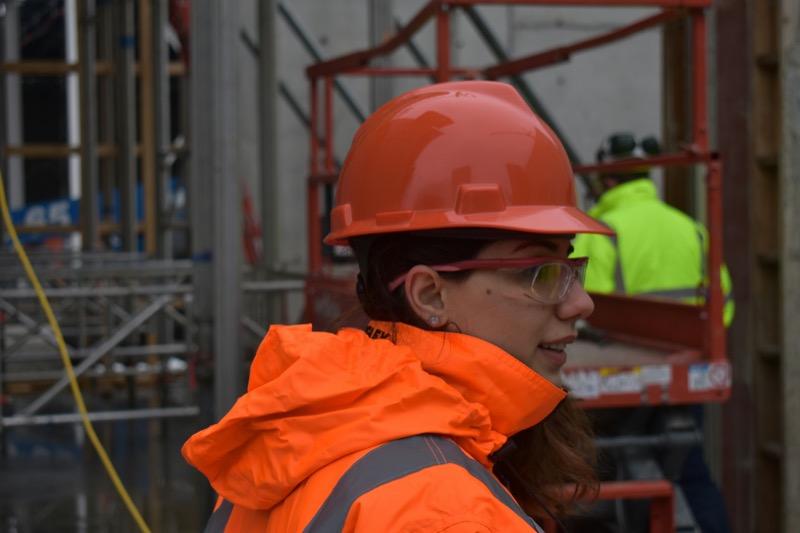Want to read in Dutch? Click here
Recent research has shown that women still often have to work with personal protective equipment (PPE) that doesn’t fit properly. As a result, their feet, hands, head, and eyes are less well protected than those of their male colleagues.
That’s why 83% of people working with PPE feel that more attention should be paid to this issue. However, only 1% actually takes the female gender into account when purchasing protective equipment. In this article, I delve deeper into this topic and look for solutions.

Research on personal protective equipment for women
The research was conducted among 891 respondents from England and Ireland, all of whom work in health and safety roles across various sectors such as logistics, the food and beverage sector, the automotive sector, and the pharmaceutical sector. This research was led by RS, a digitally supported provider of product and service solutions for industrial businesses. The aim was to gain an understanding of health and safety within these industries and to identify priorities.
While the research was broadly based, in this article, I focus on the findings related to personal protective equipment for women, as these results are particularly noteworthy…
Women are ignored in the procurement of personal protective equipment
As mentioned earlier, 82% of respondents (85% of whom are between 18 and 31 years old) believe that more attention should be paid to personal protective equipment for women. Despite 71% of the respondents being male, they acknowledge this need. This is also evidenced by the fact that 25% of respondents work in organizations where at least 40% of the workforce is female.
The research reveals that work shoes (62%), work clothing (59%), and especially high-visibility clothing (45%) with a female fit deserve more attention.

Yet only 1% of respondents say they take women into account when purchasing personal protective equipment.
Katherine Evans, founder of Bold as Brass, a network association for women in construction, is not surprised by these figures.
“Companies say this is an important issue, but then buy the cheapest items they can find. They do not see that the money they set aside for personal protective equipment outweighs the costs of a missing employee. And they certainly do not see that telling a woman she needs something that fits a man due to a $4 difference is essentially telling a woman she is not worth it.”
Women are not small men
It is often said that women should choose a smaller size when it comes to PPE. While this may seem logical at first glance, it is not straightforward in practice. Protective equipment is generally designed for the male body, and companies that believe in the convenience of unisex fits in the workplace ignore the fact that women are not small men.
In the 1970s and 1980s, the US military collected various anthropometric data to develop protective equipment that fits well. This data shows that the body sizes and proportions of women differ in such a way that they cannot simply wear a small men’s size.
Kelly Fernandes, a consultant at the Canadian Workplace Safety & Prevention Services, emphasizes that incorrect PPE can be dangerous.
“Women typically have shorter torsos and legs than men, but they are wider in the chest and hips. They also have smaller hands and fingers of varying sizes. If personal protective equipment does not fit properly, it does not provide effective protection against workplace hazards. And that can lead to injury.”
Preferably no protection
The question is how we can solve this problem. Although it is often said that women should speak up, this is not the solution. The British and Irish research shows that 83% of people working with PPE are aware of the need for more attention to protective equipment for women because women do speak up.
The problem lies in how this feedback is handled. Women who indicate that their protective equipment does not fit well are often dismissed as ‘difficult employees’. Research shows that addressing this problem is a major obstacle. Women are told that their size is not available and that they should ‘stop complaining’. Although the range of protective equipment for women is considerably smaller than that for men, it does exist. Just like with women’s work clothing, it’s a matter of searching well.
When there are no good protective equipment available, women are more likely to choose not to wear them. As dangerous as this may sound, working with items that don’t fit well often poses more risk than not wearing them at all. For example, a woman once told me that her employer only purchased gloves in the average men’s size, resulting in her getting caught on things during work. The same goes for oversized shoes, which can easily cause tripping.
The solution for Personal Protective Equipment for women
So no, it’s not the fault of women who speak up. Nor is it due to the supply. And they’re not complaining.
It’s about being taken seriously. Unfortunately, we live in a society where this often doesn’t happen. Women generally endure medical problems longer because their complaints are not taken seriously. They are less well protected in cars because airbags are made for the male body. And they are also more often interrupted during conversations than men.
These are just a few facts that show that the problem of PPE is not isolated. The risk is that when women are not heard, they are more likely to remain silent. Although we have become more outspoken over the years, women are used to not always being heard. And that nothing is done with what they raise. Some will continue to pound their fists on the table, but some will accept it. With all the consequences and risks that entails.
Meanwhile, technical companies are clamoring for staff and want to attract more women. If you want to attract them, take them seriously.
Fix the system, not the women – Woman inc.
Regards,
Aileen
